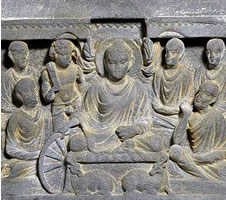 |
| Setting the wheel into motion |
Asalha Puja—also known as Dhamma* Day—is one of Theravada Buddhism’s most important festivals, celebrating as it does the Buddha’s first sermon in which he set out to his five former associates the doctrine that had come to him following his enlightenment. This first pivotal sermon, often referred to as “setting into motion the wheel of dhamma,” is the teaching which is encapsulated for Buddhists in the four noble truths: all life is suffering (dukka); suffering is caused by craving (tanha); there is a state (nibbana) beyond suffering and craving; and finally, the way to nibbana is via the eightfold path.** Whatever differences there may be between various schools and traditions of Buddhism, they all revolve around the central doctrine of the four noble truths.
This first sermon is not only the first structured discourse given by the Buddha after his enlightenment, it also contains the essence of all his subsequent teaching. At the end of the talk, one of the five participants recounted his understanding of what had been said and asked to be received as a disciple, a request the Buddha granted, thus establishing the first order of monks.
The month of Asalha is the start of the monsoon, during which the Buddha and his monks and nuns would suspend their wandering lifestyle. Even today monasteries keep a three month ‘rains retreat’, which starts on Dhamma Day and ends on Pavarana. Those wishing to join the order but not yet able to totally forsake their other life may be ordained as ‘short-term monks’, i.e. committing themselves to the monastic life for the period of the retreat.
**Right understanding, right thoughts, right speech, right action, right livelihood, right mindfulness and right concentration.